Some 30 years ago, NASA’s Magellan mission “closed the book” on Venus. Now, a new generation of astronomers think the planet next door deserves a second chance.

NASA
Presentations at the Lunar and Planetary Science Conference usually focus on the Moon, Mars, asteroids, and comets. But at this year’s symposium, an entire day’s worth of talks were dedicated instead to Venus. Why is Earth’s “evil twin” so hot right now?
The unofficial end of NASA’s Venus program, following the completion of the Magellan mission, was part reactionary disappointment, part practicality. Instead of a primordial jungle teeming with alien life, we had found an impassable, barren hellscape. Departments all over the world shifted their focus to Mars, because although it’s further off, it’s a much easier planet to visit and study.
Recently, however, interest in Venus has risen again. This is due in part to new high-resolution data from the European Space Agency (ESA) Venus Express and Japan’s Akatsuki orbiter, and in part because of interest from the exoplanet community. Materials science advances enable electronics to survive Venus’s hot and acidic conditions for longer, making in-situ missions more feasible.
Amid these developments, early career astronomers have begun to see our nasty neighbor’s hellish environs as an upside: a mystery begging to be solved. The slate of Venus missions recently approved by NASA, ISRO, ESA as well as planned by private entities reflects this resurgent interest and promises to address a host of open questions.
This year’s “Venus Day” at the LPSC provides a good forecast of the various topics in geology, seismology, and atmospheric science that planetary scientists are hoping to explore over the years to come. Here is a brief, non-comprehensive selection of the research presented. Some of the studies have been peer reviewed, while others are at earlier stages of development.
Did Venus Have Oceans?
Venus is currently inhospitable: It seems unlikely that any form of life, even extremophiles, could survive there now. But some climate models suggest that our neighboring planet might have been habitable as recently as 700 million years ago.
If that’s true, clues ought to remain in its atmosphere. Ancient oceans, for example, would have had to evaporate, since the planet is dry now. When water molecules evaporate from a planet, hydrogen easily escapes into space while heavier oxygen sticks around. We don’t see a significant amount of oxygen leftover in the atmosphere, but Sasha Warren (University of Chicago) and colleagues suggest the planet might have hidden its oxygen among the basalts of lava flows. Their model of Venus’s atmospheric history frees up the possibility that surface water once existed there.
“It’s possible that the oxygen reacted with the basalt rocks on the surface,” Warren says. “Basalt has a lot of iron in it, and iron can be oxidized, potentially locking [oxygen] up in minerals in the crust. This could be why we don't see it today in the atmosphere.”
While oxidized rocks would probably have been subsumed into the crust by now, thus eluding direct detection, future missions could see indirect signatures of the surface’s history.

NASA
Another study, however, suggests that Venus never had much water at all. Cedric Gillmann (Rice University) and his colleagues built a computer model to dig into water’s past on the planet: when and how much was delivered and where it all went. The model includes ways for water to arrive on the planet’s surface, such as volcanic outgassing and delivery via comets, as well as multiple ways for water to escape the atmosphere.
The relative simplicity of Venusian gas exchanges, as compared to Earth, enabled the team to turn the clock back and infer the planet’s volatile history, Gillmann says.
Their calculations ultimately suggest that if Venus did have ancient oceans, they carried only a tenth the water that Earth’s oceans have today.
Are Venusian Tesserae Old or Young?
Another focus of renewed interest is a type of Venusian terrain known as tesserae. Some have suggested that these regions of deformed, folded rock represent the oldest preserved crust on Venus. As such, they might shed light on whatever global catastrophe(s) Venus endured in its past.
But a new study, led by Paul Byrne (Washington University in St. Louis), claims that some tesserae formation may have taken place geologically recently ― and could even be ongoing.

NASA / JPL
This would be surprising because Earth and Venus are the same age and have similar compositions, yet our planet’s mantle hasn’t had large-scale formations like tesserae since at least the Jurassic period.
Byrne’s team analyzed large swathes of surface radar imagery, and came to the conclusion that at least in some regions, tesserae do not seem to be distinct from surrounding terrain; in fact, they seem to be part of a continuous gradation. For example: the directionality of certain features around Ovda Regio are parallel to the tectonic fabric of the tessera there, meaning there is no discernable boundary between them.
This observation is problematic to our current understanding of how areas with smooth plains, ridged plains, and tesserae form over time.
We are also ignorant about the composition of tesserae, which is quite important when dating geological formations. This new analysis, plus the fact that we don’t actually know what tesserae are made of, calls into question the assumption that they are universally ancient. But why would Venus present as “geologically younger” than Earth?
Team member Richard Ghail (Royal Holloway University of London) explains: “Venus might be cooling less efficiently because it's effectively sitting under a blanket at 450 degrees Celsius,” he says. Plate tectonics, which occurs only on Earth, is also much more efficient at recycling heat from the core, he adds.
The research studies presented at the LPSC make clear that even the most basic questions of Venus’s history remain wide open. Did ancient Venus once host water? Or even oceans? Can current surface formations shed light on the planet’s past? These are questions that future missions to our sister planet will help answer.
 0
0








Comments
You must be logged in to post a comment.